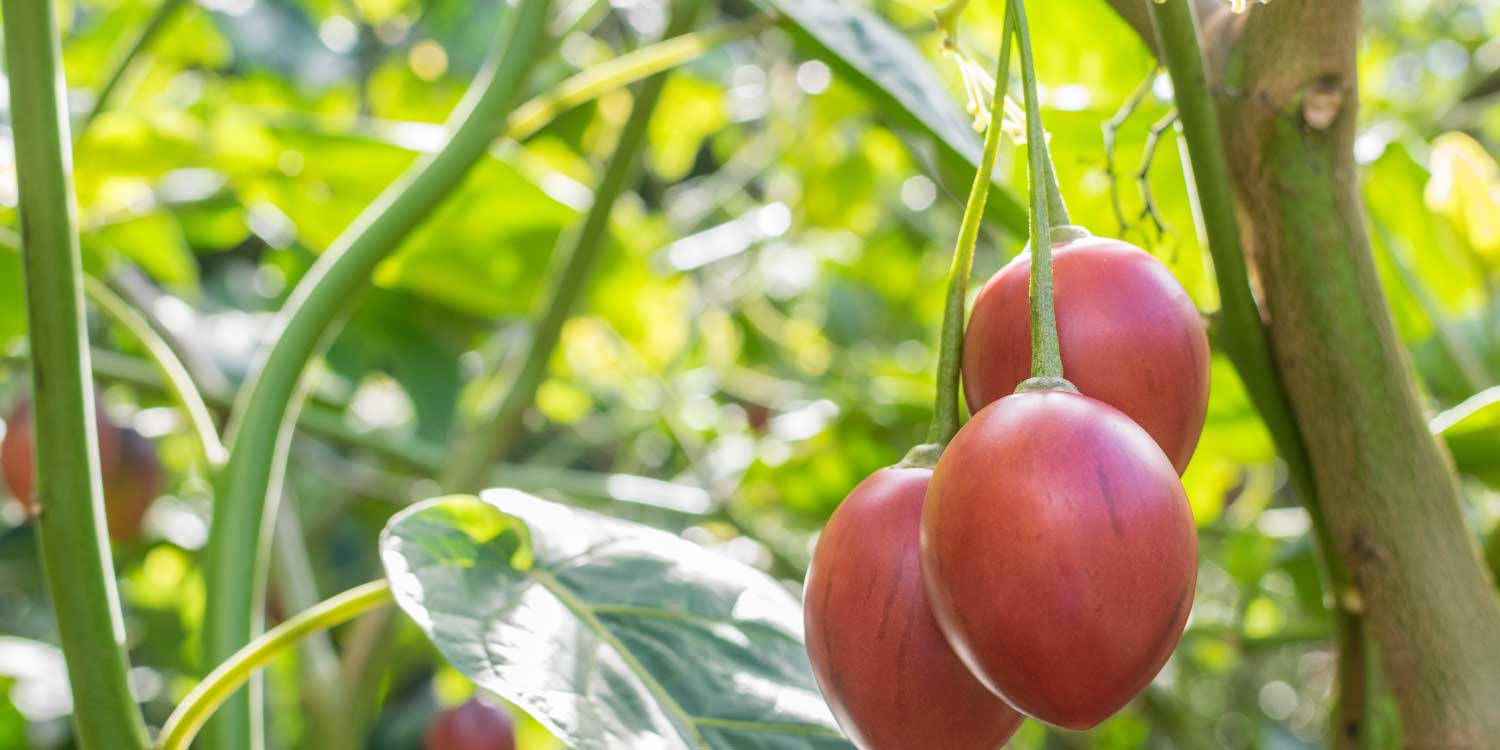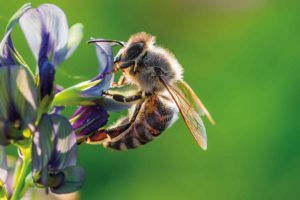Tamarillo, best known by the name Tree Tomato in Kenya is a fast-growing tree belonging to the Solanaceae family, which grows up to approximately 5meters.
The tree usually forms a single upright trunk with lateral branches and flowers and fruits hang from the lateral branches. The leaves are large, simple and perennial and have a strong pungent smell while the flowers are pink-white and form clusters of 10-50 flowers. They produce 1 to 6 fruits per cluster.
In Kenya, tree tomato is grown in Migori, Kisii, Kakamega, Meru, Murang’a, Embu, Nyeri, Nyandarua, Kericho, among others.
Areas, where citrus are cultivated, provide good conditions for tree tomatoes.
The fruit is a many-seeded berry and egg-shaped, which looks like a medium-sized tomato, although it is not a true tomato.
Fruits can be eaten fresh by scooping the flesh from halved pieces.
For other uses, the skin must be removed which is easily done by pouring boiling water over the fruits and letting it stand for about 5 minutes before peeling.
The tree tomato flesh can be added to stews to make unique flavor and the fruits are tasty and decorative in salads making appetizing desserts.
Fresh tree tomato is often blended with sugar and water to make refreshing juice.
Peak production is reached after 3-6 years depending on the cultivar, and the life expectancy of the crop is about 12 years.
VARIETIES
There are various tree tomato varieties which are mostly distinguished by their color.
- Red fruits variety– mostly used for fresh market fruit due to their appealing color.
- Yellow fruits variety– these fruits have a superior flavor and hence good for preserving.
- Dark-red or Black variety-the fruits are large and of higher quality.
ECOLOGICAL REQUIREMENTS
Tree tomatoes prefer subtropical climate.
For vigorous growth, they require well-drained fertile soil which is rich in organic matter. The soil must be permeable since the plants are not tolerant to water-logging.
Tree tomatoes grow naturally on soils with a pH of 5 to 8.5 and do not tolerate tightly compacted soil.
Although they can be planted under irrigation, rainfall between 600 and 4000 millimeters is suitable. The crop cannot survive in areas with prolonged drought and must have ample water during the dry season. Application of mulch retains moisture in a tree tomato plantation and also reduces weed growth.
Annual temperatures between 15 and 20 °C are ideal for tree tomato production. It is intolerant to frost (below -2 °C) and drought stress
Tree tomatoes grow well in altitude of between 1,500m to 3,000M above sea level.
FIELD OPERATIONS
Propagation of tree tomato is by seeds or cuttings. However, the easiest way to grow tree tomato is through seedlings.
Seedlings first develop straight, about 1.5 to 1.8 meters tall trunks, before they branch out, while cuttings develop into shorter bushy plants with low-lying branches.
Selection of planting site is very important
Planting
Seeds should be treated against soil-borne pests, soil-borne fungal infections and seed dormancy. This is achieved through drenching the nursery with a mixture of PYRAMID 700WP 100g +LOYALTY 700WDG 10g+ OPTIMIZER 20ml in 20litres of water.
The distance from one plant to the next should be 4 feet and space between one row and the next should be 5 feet.
Cuttings should only be got from plants which are 1-2years old with a thickness of 1.5 to 2.5 cm and a length of 45 to 75 cm. They are sown directly at a spacing of 3×3m.
Plants grown from cuttings branch out earlier and result in more shrub-like plants that are more suitable for exposed sites. They should not be allowed to bear the first year.
Cultural practices
Weeding
It is essential to keep the fields free from weeds. This is because weeds compete for growth factors like nutrients, space, water, sunlight as well harboring pathogens and these greatly affect crop performance
CLAMPDOWN 480SL 200ml/20l is a recommended non-selective herbicide.
Mulching
This has several benefits to the crop, e.g. conservation of moisture, suppression of weed growth, nutrient supply, and improvement of soil structure and water infiltration, checking of soil erosion and topsoil temperature as well as reduction of pests’ incidence.
Watering
To maximize and stabilize production, water and nutrient inputs should be provided when needed. The plants need a continuous supply of water due to their shallow root system. Water stress results in a decrease in plant growth and production.
Shelter
The plants should be protected from strong wind because their shallow root system does not provide enough stability and the lateral branches are fragile and break easily when carrying fruits.
Pruning
When the tree is about 1 to 1.5 metres in height, it is advisable to cut the roots on one side and lean the tree to the other (in the direction of the midday sun at about 30 to 45 degrees). Pruning helps to control fruit size, plant size and harvest date.
It allows fruiting branches to grow all along the trunk rather than just at the top.
Support
At fruit bearing stage, tree tomatoes need support to prevent branches from breaking off when laden with fruits. The trees can easily be blown over by the wind as they are shallow rooted.
PESTS AND DISEASES MANAGEMENT
Pests
Tree tomatoes are generally pest resistant.
The main pests that attack the tree include the aphids, thrips whiteflies, and nematodes
Aphids
These are small black or greenish soft-bodied sap-sucking insects and members of the superfamily Aphidoidea.
They feed by piercing and sucking sap on tender shoots, especially on the lower leaf surface. The attacked shoots become stunted and the leaves are curled and twisted.
As they feed, aphids excrete honeydew which favours the growth of sooty mold which affects photosynthesis.
Spray KINGCODE ELITE 50EC 10ml/20l or PENTAGON 50EC 10ml/20l or PRESENTO 200SP 5g/20l
Whiteflies
They are tiny sap-sucking white-winged insects which cause damage by inserting their stylets into leaf veins and extracting nourishment from the phloem sap.
The affected plant loses its vitality resulting in yellowing, downward curling and an eventual drying of leaves.
Spray TAURUS 500SP 10g/20l or KINGCODE ELITE 50EC 10ml/20l or PROFILE 440EC 30ml/20l
Nematodes
These are microscopic parasites found in the soil, and whose infestation leads to wilting of the plant.
When the infested plants are pulled from the soil, the roots can found to be distorted, swollen and bearing knots or galls. These roots eventually rot causing an eventual death of the plant.
Drench the planting holes with ALONZE 50EC 6ml/20l or always mix 2kg ADVENTURE 5GR with 50kg of basal fertilizer during planting or top dressing.
Diseases
If not controlled at early stages, these diseases cause significant yield losses.
CADILLAC 800WP is a preventive fungicide which should be applied before disease invasion for protection purposes.
Powdery Mildew
Infection is characterized by the development of gray-white powdery growth majorly on leaves and stems, which causes them to become distorted.
The plant may eventually wilt as disease severity increases.
Spray RANSOM 600WP 15g/20l or DISCOVERY 400SC 10ml/20l or DUCASSE 250EC 20ml/20l
Blight
Initial infection occurs in older leaves with concentric dark brown spots developing on the leaves. As infection advances, infected leaves turn yellow and fall off. On stems, spots without clear contours are seen. The lesions enlarge as severity increases.
Spray EXEMPO CURVE 250SC 15ml/20l or FORTRESS GOLD 40g/20l or MEGAPRODE LOCK 525WP 15g/20l
Mosaic
This is a viral disease, and the virus is mechanically transmitted and also spread by several species of aphids in nonpersistent mode.
Attacked leaves have reduced size and patches of dark-green tissue alternating with yellow-green. Generally, the plant becomes stunted and the quality of fruits is greatly reduced.
Control aphids (vectors) with KINGCODE ELITE 50EC 10ml/20l or PENTAGON 50EC 10ml/20l or PRESENTO 200SP 5g/20l
NUTRITION & NUTRITIONAL DEFICIENCIES
In order to maintain a healthy growth, tree tomatoes require continuous fertilization
This should include the supply of both macro and micronutrients which are provided through application of basal and foliar fertilizers.
For instance;
At planting, soil should be mixed with manure and/or DAP and top dressing done using CAN.
To promote rapid root development and stimulate plant growth, GOLDCHANCE SUPER START 50g/20l or LAVENDER 20ml/20l should be sprayed.
For a robust vegetative growth, GOLDCHANCE SUPER GROWTH 50g/20l or LAVENDER 20ml/20l are sprayed to supply enough Nitrogen which is highly required in the development of foliage, important for photosynthesis, besides other elements.
During flowering and fruiting stages, spray GOLDCHANCE SUPER FLOWERS & FRUITS 50g/20l, VITABOR GOLD 60ml/20l, and DIMIPHITE 10ml/20l. These provide nutrient elements needed to induce flowering and fruiting, prevent flower abortion as well as ensure production of good quality fruits.
NB; Application of OPTIMIZER 10ml/20l boosts the crop’s immunity, manages stress and improves the general performance of the crop. This can be done at any growth stage of the crop.
Deficiencies
Nitrogen deficiency
The growth rate of deficient trees is highly reduced and leaves turn yellow, starting with the older ones.
Correction; spray LAVENDER 20ml/20l or GOLDCHANCE SUPER GROWTH 50g/20l
Phosphorous deficiency
The deficient plants become stunted, internodes shorten, leaves turn purplish and there’s production of poor quality flowers which bear low-quality fruits.
Correction; spray DIMIPHITE 30ml/20l or GOLDCHANCE SUPER START 50g/20l or LAVENDER 20ml/20l
Potassium deficiency
The young leaves become small, dull and cupped while the older ones develop marginal chlorosis. In severe cases, leaves dry.
Correction; spray DIMIPHITE 30ml/20l or GOLDCHANCE SUPER FLOWERS & FRUITS 50g/20l or PLANT SOUL 30ml/20l
Boron deficiency
The growing points of the affected trees die and leaves become chlorotic, then necrotic.
Fruit quality is greatly reduced.
Correction; spray VITABOR GOLD 20ml/20l or BOND CHANCE 50ml/20l
MATURITY, HARVESTING & POST-HARVEST HANDLING
The tree grows very quickly and is able to carry fruits after 1.5 to 2 years though in some favorable conditions they carry fruits in a lesser span of time. The plant is day length-insensitive.
Fruits do not mature simultaneously unless the tree has been pruned.
Tree tomatoes are ready for harvesting when they develop the red or yellow color and harvesting is achieved through simply pulling the fruits from the shrubs with a snapping motion leaving the stalk attached.
The fruits can be stored in the refrigerator for up to 10 weeks, but temperatures below 38°F can cause the skin to discolour.
Tips!
- Whenever doing any foliar spray, the product (insecticide, fungicide, foliar feed or herbicide) should be mixed with INTEGRA 3ml/20l. This is a sticker, spreader, and penetrant, which improves the efficacy of the product.
- All basal fertilizers and manure should be mixed with HUMIPOWER at the rate of 1kg Humipower into 50kg fertilizer or 1 ton of manure. Humipower helps to improve the nutrient uptake by the crop, stimulates growth, and improves soil structure, among other benefits.
- Timely application of pesticides and fertilizers is very important.






